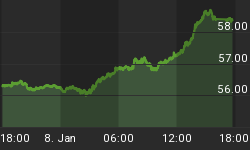Net foreign capital flows into the US fell 34% to a 25-month low of $46.7 bln in April from a revised $70.4 bln in March (initial was $69.8 bln). The $46.7 bln in net capital flows fell short of the $63.4 billion trade deficit for the same month.
Our rationale for expecting $55 bln figure (see morning note) -- lower than the consensus forecast of $60 bln-- was the damage suffered by the dollar in the month of April. April's dollar decline was the biggest monthly decline since December - as measured by Fed's Broad Dollar Index. Historically, the weakest months for the TICS data have been those of significant dollar declines as foreign investors grow averse to US assets due to the currency factor.
Considering the dollar's 2.6% decline in May (trade weighted terms) and the S&P 500's 3.1% drop in the same month, the May TICS report (due in July) should show further declines in net foreign capital flows, which will indicate a widening shortfall of trade deficit financing.
July will likely prove to be an especially dismal month for the dollar as not only there is no scheduled FOMC meeting (de facto rate pause), but also will reveal the advanced Q2 GDP report, likely to show growth slowing sharply to 2.7%-2.9% from 5.3% in Q1. With such a notable growth slowdown, it would be unfathomable for the Fed to raise rates 2 weeks later on August 8. Those evolving dynamics in monetary policy expectations should bring about a conclusion to the Fed's tightening campaign.
POSITIVES
- The sole positive component of the TICS report was the sharp jump in net official (central bank) purchases of US Treasuries to $10.7 bln, after being net sellers at $6.3 bln in March. The increase proved barley sufficient to produce an 8% increase in total net purchases of US treasuries at $3.3 bln after private accounts were net sellers at $7.8 bln.
NEGATIVES
-
Net foreign purchases of US stocks tumbled 66% to $6.5 bln, the lowest since November 2005. Considering the sharp equity sell-offs in May, foreign flows into US equity could be in the red for that month, casting an ominous vacuum in the financing of the trade deficit.
-
Net purchases of US Treasuries by private accounts (usually hedge funds) plunged 180% to a net selling of $7.8 bln. This was the biggest net selling by private entities of US treasuries since October 2003.

-
Net foreign purchases of US corporate bonds fell 66% to $31 bln, while net buys of government Agencies fell 18% to $15.3 bln.
-
US residents eased their net purchases of foreign stocks by 18% to $9.8, likely a result of the global sell-off in equities, which is likely to have been exacerbated in May.
-
Japanese holdings of US Treasuries edged up 0.3% to $639 bln, but remained well off their highs of $698 bln in 2004. to $9.8, likely a result of the global sell-off. With 31% of total foreign treasury holdings, Japan is the biggest holder of US Treasuries. Well aware of the currency repercussions of maintaining a massive USD exposure at a time when the Bank of Japan is expected to tighten moneteray policy, Tokyo continues in its quiet campaign of gradually lightening its USD holdings.

The dollar is ending the session modestly lower except against the yen, where the pair is little at 115.00. The unexpected jump in the NY Fed survey to 29.0 from May's 12.9 surprised expectations of a 10.9 figure and boosted the dollar.
The 295K reading in weekly jobless claims also boosted the dollar, defying expectations of a rise from 302K to 320K. But the upward revision in the previous reading to 315K from 302K helpd neutralize overall decline.
The 0.1% drop in industrial production was the first decline in 4 months but it did not accelerate the post-TICS dollar slide.
The smaller than expected decline in the June Philly Fed to 13.1 from 14.4, accompanied by a rise in the new orders and the employment indices helped allay fears of a broadening slowdown in the regional surveys.
For now, the dollar can continue obtaining its support from an assured tightening in June and the episodic rise in expectations for an August rate hike, which we do not see materializing at this point. With the euro finding a vital base at the expense of the weak TICS report and the yen remaining the weakest link courtesy of the Bank of Japan's stalling. We expect to EURUSD testing the 1.25 support, and pressured below 1.2750. The status quo shall be sustained as long as the ECB refrains from hinting a July or August rate hike and the Fed sticks to its data dependence rhetoric.
The Japanese yen is being mainly pressured by the Bank of Japan's slowing road to higher rates. But with the 100 day MA slipping below the 200 day MA for the first time in exactly one year suggests that a top is around the corner. Indeed, we may take out the 115.42 high, but selling pressure is expected to be fierce at 115.75-80.
















